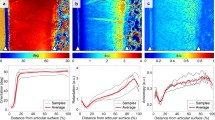Abstract
We report a simple and efficient MR method for the evaluation of trabecular bone quality. This technique is based on detection and imaging of Multiple Spin-Echoes (MSE), a manifestation of the dipolar field generated by residual intermolecular dipolar couplings in liquids. In the particular implementation we have used, originally proposed by Bowtell [J. Magn. Reson. 100 (1992) 1; J. Magn. Reson. 88 (1990) 643; Phys. Rev. Lett. 76 (1996) 4971]. multiple spin echoes (MSE) are refocused in a two-pulse experiment in the presence of a correlation linear magnetic field gradient Gc. This gradient generates a magnetisation helix and results in the spatial modulation of the sample magnetisation. In heterogeneous systems, the amplitude of the MSE signal depends on sample heterogeneity over a distanced= π.(γ/Gcτ) which is half a cycle of the magnetisation helix, thus providing a novel contrast mechanism that can be tuned to a specific length scale. We have exploited this mechanism to study young bovine trabecular bone samples ex-vivo. We show that MSE images present a different contrast from conventional MR images, and that, by varying the experimental parameters, the image contrast can be related to specific trabecular pore sizes. The potential of this technique for the early diagnosis of osteoporotic diseases is discussed.
Similar content being viewed by others
References
Francis RM. Osteoporosis, pathogenesis and management. Dordrecht: Kluwer Academic Publishers, 1990.
Parfitt AM. Age related structural changes in trabecular and cortical bone: cellular mechanisms and biomechanical consequences. Calcif Tissue Int 1984;36:S123–8.
Ford JC, Wehrli FW. In vivo quantitative characterisation of trabecular bone by NMR interferometry and localised proton spectroscopy. Magn Reson Med 1991; 17:543 -51.
Majumdar S. Thomasson D, Shimakawa A, Genant HK. Quantitation of the susceptibility difference between trabecular bone and bone marrow: experimental studies. Magn Reson Med 1991:22:111–27.
Wehrli FW. Ford JC Attic M. Kressel HY, Kaplan FS. Trabecular structure: preliminary application of MR interferometry. Radiology 1991:179:615–21.
Ford JC, Wehrli FW. Chung HV. Magnetic field distribution in models of trabecular bone. Magn Reson Med 1993:30:373–9.
Jara H. Wehrli FW, Chung HW, Ford JC. High-resolution variable flip angle 3D MR imaging of trabecular microstructures in vivo. Magn Reson Med 1993:29:528–39.
Chung HW. Wehrli FW. Williams JL, Wehrli S. Three-dimensional nuclear magnetic resonance microimaging of trabecular bone. J Bone Miner Res 1995:10:1452–6.
Richter W. Lee S, Warren WS. He Q. Imaging with intermolecular multiple quantum coherences in solution nuclear magnetic resonance. Science 1995:267:654 -7.
Warren WS. Richter W. Andreotti AH. Farmer BT. Generation of impossible cross-peaks between bulk water and biomoleeules in solution NMR. Science 1993:262:2005–9.
Bifone A. Payne GS. Leach MO. In vivo multiple spin echoes. J Magn Reson 1998:135:30–6.
Zhong J. Chen Z, Kwok E. In vivo intermolecular double-quantum imaging on a clinical 1.5 T MR scanner. Magn Reson Med 2000:43:335–41.
Rizi RR. Ahn S, Alsop DC. Garrett-Roe S. Mescher M. Richter W, Schnall MD, Leigh JS. Warren WS. Intermolecular zeroquantum coherence imaging of the human brain. Magn Reson Med 2000:43:627–32.
Bowtell R. Indirect detection via the dipolar demagnetizing field. J Magn Reson 1992:100:1–17.
Bowtell R, Bowley RM. Glover P. Multiple spin echoes in liquids in a high magnetic field. J Magn Reson 1990:88:643–51.
Bowtell R. Robyr P. Structural investigation with the dipolar demagnetizing field in solution NMR. Phys Rev Lett 1996:76:4971–4.
Lian J. Williams DS, Lowe IJ. Magnetic resonance imaging of diffusion in the presence of background gradients and imaging of background gradients. J Magn Reson A 1994:106:65–74.
Capuani S, Curzi F, Alessandri FM, Bifone A. Maraviglia B. Characterization of trabecular bone by dipolar demagnetizing field MR imaging. Magn Reson Med 2001:46:683–9.
Author information
Authors and Affiliations
Corresponding author
Rights and permissions
About this article
Cite this article
Capuani, S., Alessandri, F.M., Bifone, A. et al. Multiple spin echoes for the evaluation of trabecular bone quality. MAGMA 14, 3–9 (2002). https://doi.org/10.1007/BF02668181
Received:
Revised:
Accepted:
Issue Date:
DOI: https://doi.org/10.1007/BF02668181




